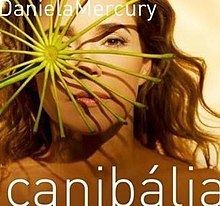Recorded April 2008 - June 2009 Label Ariola Records | Length 55:40 Release date 23 October 2009 | |
 | ||
Released October 23, 2009 October 24, 2009 October 27, 2009 November 3, 2009 November 3, 2009 Canibália(2009) Canibália Ritmos do Brasil(2011) Genres Axé, Samba, Música popular brasileira, Reggae, Hip hop music Similar Daniela Mercury albums, Axé albums, Other albums | ||
Canibália (English: Cannibalistic) is Daniela Mercury's ninth studio album, released on October 23, 2009 in Brazil by Sony Music. It was released on October 24 in the United States and on October 27 in the European Union. Mercury's first studio release in four years brings not only an eclectic sound, but also five different covers.
Contents
Abertura show canib lia de daniela mercury canec o rj 23 08 09
Information
The album was produced by five musicians: Mercury herself and her son Gabriel Póvoas, in addition to Ramiro Musotto, Alfredo Moura, Mikael Mutti. According to Mercury, Canibália is the synthesis of the eclecticism of her work. On September 11, 2009, as the album was under post-production, Musotto died of cancer at age 45. A longtime collaborator of Mercury, he produced the electro-samba tracks of Canibália with her ("Benção do Samba" – a mash-up of samba classics "Na Baixa dos Sapateiros", "O Samba da Minha Terra", and "Samba de Bênção" – and "Tico-Tico no Fubá"). Mercury's friend and producer Neguinho do Samba, credited as "samba reggae creator", died later that month of a heart attack.
Mercury chose the title Canibália because she feels "cannibalized" since her breakthrough in the early 1990s with the release of O Canto da Cidade. She had postponed the release of Canibália several times. Seven of the album's fourteen tracks were written by Mercury, making this her most authoral release since 1994's Música de Rua. Unlike Balé Mulato, whose tracks complemented each other, Canibália is an eclectic mix of sounds. In honour of Carmen Miranda's centenary, Mercury recorded a "duet" with her in the cover of "O Que É Que A Baiana Tem?", which includes the original 1939 phonogram. Mercury recorded another Miranda classic, "Tico-Tico No Fubá", which received the strong beat of Os Mutantes guitarist Sérgio Dias.
Beyond Carmen Miranda, Mercury also pays a tribute to the Brazilian cinema, in the track "Trio em Transe" (a reference to Glauber Rocha's Terra em Transe), and to the Native Brazilians, in the track "Dona Desse Lugar", that has arrangements, sounds and instruments specific of indigenous tribes. Mercury also pays a tribute to the Afro Brazilians in the track "Preta", a duet with Seu Jorge which is actually a mash-up of the songs "Eu sou Preta", "Sorriso Negro", and "Rap do Negão". Following the footsteps of Vanessa da Mata and Ana Carolina, which released English language songs, Mercury recorded "This Life is Beautiful", written and performed with Haitian singer Wyclef Jean. In "Oyá Por Nós", Mercury revisits the African roots of Brazilian spirituality. The album also features a cover of Chico Buarque's "O Que Será? (A Flor da Pele)", also performed as a duet with the late Mercedes Sosa on Cantora. In "Cinco Meninos", the whole Mercury family gathers to sing.
Singles
Songs
1Trio em transe3:12
2Oyá por nós3:57
3O que é que a Baiana tem3:30
